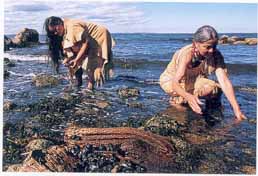Book Review: 1621, A New Look at Thanksgiving
Just in time for Thanksgiving comes a fresh look at the holiday and its traditions from Catherine O'Neill Grace and Margaret M. Bruchac. The book is 1621, A New Look at Thanksgiving. From the very beginning, we know this is a look back at what we might not have known. The initial focus is on the Wampanoag, the Native American people who shared that harvest feast with the Pilgrims so long ago. We know we're on new ground here when we learn the Wampanoag word for harvest time: Keepunumuk. We also learn that the Wampanoag called the land Patuxet and that the Pilgrims have renamed it New Plymouth. The authors implore their readers to examine the Thanksgiving story from both perspectives (Pilgrim and Native American) and consider it a shared history.
We learn about the Wampanoag language, Wopanaak, and how the language has one word that can mean a whole sentence in English. Interesting fact: According to this book, the first Bible printed in the New World was in Wopanaak. All this is meant to give the reader a balanced perspective. Kids (and teachers and parents) who read this book probably already know about the Pilgrims and why they left England and how hard their winters were and so on. This book gives the Native American background to go along with the Pilgrim story. The result is a wonderfully balanced examination of an event that has, at times, taken on legendary aspects. The book even has a page titled "Making a Myth," which dispels such myths as the clothes the Pilgrims wore or even the food they ate. (No pumpkin pie or cranberry sauce! See The Thanksgiving Feast.) Another excellent touch is the facing pages recipes: one Wampanoag, one Pilgrim. Through the use of these recipes, chronologies, many excellent photos, and a narrative providing a fresh eye, this book succeeds in its mission: to make the reader think and to look at an event from more than one perspective. See also Mayflower 1620, a re-examination of the famous voyage that brought the Pilgrims to America. Graphics courtesy of National Geographic |
|
Social Studies for Kids
copyright 2002–2024
David White



 Again
by way of introduction, we learn more about the Wampanoag in
their own words. We see them fishing, and we learn about
them hunting and gathering. We learn their practices of
reusing resources and caring for the environment. We see a
map of Wampanoag territory (which made up what is now
southeastern Massachusetts).
Again
by way of introduction, we learn more about the Wampanoag in
their own words. We see them fishing, and we learn about
them hunting and gathering. We learn their practices of
reusing resources and caring for the environment. We see a
map of Wampanoag territory (which made up what is now
southeastern Massachusetts).


